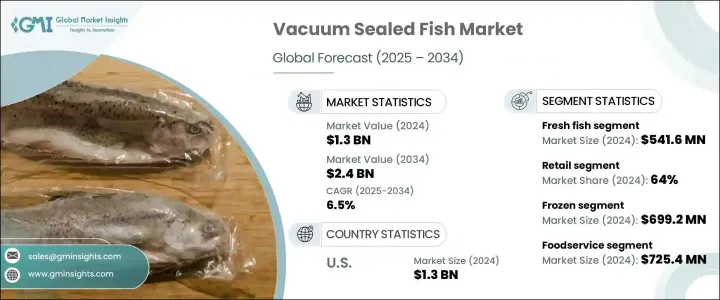
세계의 진공팩 생선 시장은 2024년 13억 달러로 평가되었으며, 편의성, 보존 기간 연장, 식품 안전성 향상에 대한 소비자 수요 증가로 CAGR 6.5%로 성장해 2034년까지 24억 달러에 달할 것으로 예측되고 있습니다.
진공 실링 기술은 공기를 제거하고 물고기를 장벽 패키지로 봉쇄하여 신선도, 맛, 식감 및 영양가를 유지하면서 부패와 박테리아의 번식을 크게 억제합니다. 바쁜 라이프스타일이 당연해지고 있는 현재, 더 많은 소비자들이 신속하게 건강하고 고품질의 식품을 요구하게 되어, 진공 씰의 인기가 높아지고 있습니다. 건강 지향 구매자는 보존제를 사용하지 않고 자연의 품질을 유지할 수있는이 포장 방법에 특히 매료되었습니다. 환경 의식이 증가함에 따라 수요가 증가하고 있으며, 많은 소비자들이 지속 가능한 포장과 식품 폐기물의 최소화를 우선시하고 있습니다. 소매업체와 브랜드는 진공 씰의 제품 라인을 확대하고 천연 생선과 유기농 물고기의 품종을 홍보하고, 환경 친화적인 포장의 혁신을 도입함으로써 이러한 동향을 활용하고 있습니다. 국제 무역의 확대와 콜드체인 물류의 발전으로 세계의 진공팩 생선 산업은 향후 10년간 강력한 성장을 이룰 태세가 갖추어지고 있습니다.

진공팩 생선 시장의 성장은 소매 유통 채널의 확대, 가처분 소득 증가, 곧 먹을 수 있거나 조리가 쉬운 해산물 요리에 대한 식욕 증가에 의해 더욱 지원되고 있습니다. 각 회사는 생분해성 소재와 재활용 가능한 소재로 혁신을 계속하는 한편, 유기농과 천연 생선의 선택사항으로 포트폴리오를 넓혀가고 있습니다.
| 시장 범위 | |
|---|---|
| 시작 연도 | 2024년 |
| 예측 연도 | 2025-2034년 |
| 시작 금액 | 13억 달러 |
| 예측 금액 | 24억 달러 |
| CAGR | 6.5% |
시장은 조개류, 생선, 조리된 생선 및 기타 제품으로 구분됩니다. 진공팩은 풍미와 부드러움을 가두고 위생과 편의성을 선호하는 소비자에게 신뢰할 수 있는 옵션을 제공합니다.
2024년에 3억 760만 달러로 평가된 조개 부문은 2034년까지 5억 2,530만 달러를 창출할 것으로 예상되며 강력한 성장 가능성을 보여줍니다. 승압기, 굴, 홍합과 같은 썩은 조개류는 진공 씰이 효과적입니다.
미국 진공팩 생선 2024년 시장 규모는 13억 달러로, 가치중시로 친환경적이고 편리한 해산물 옵션에 대한 기호의 고조가 원동력이 되고 있습니다.
세계 진공팩 수산업계의 주요 기업은 Bumble Bee Foods, Blue Circle Foods, Dongwon Industries, Icelandic Group, Mowi ASA, Gorton's, Pacific Seafood Group, Thai Union Group, Stolt-Nielsen Limited, Trident Seafood Corporation 등입니다. 각사는 지속 가능한 패키징으로 혁신을 이루고, 오가닉이나 천연 생선의 취급을 확대해, 소매업체와 파트너십을 맺어 유통을 확대해, 소비자의 관심을 높이고 있습니다.
참고: 위의 무역 통계는 주요 국가에만 제공됩니다.
The Global Vacuum Sealed Fish Market was valued at USD 1.3 billion in 2024 and is estimated to grow at a CAGR of 6.5% to reach USD 2.4 billion by 2034, driven by rising consumer demand for convenience, longer shelf life, and improved food safety. Vacuum sealing technology removes air and encloses fish in high-barrier packaging, preserving freshness, flavor, texture, and nutritional value while significantly reducing spoilage and bacterial growth. With busy lifestyles becoming the norm, more consumers are looking for quick, healthy, and high-quality food options, boosting the popularity of vacuum-sealed seafood. Health-conscious buyers are especially drawn to this packaging method for its ability to retain natural qualities without the need for preservatives. Growing environmental awareness has also pushed demand higher, with many consumers prioritizing sustainable packaging and minimal food waste. Retailers and brands are capitalizing on these trends by expanding their vacuum-sealed product lines, promoting wild-caught and organic fish varieties, and introducing eco-friendly packaging innovations. With international trade expanding and cold chain logistics advancing, the global vacuum-sealed fish industry is poised for robust growth over the next decade.

The growth of the vacuum-sealed fish market is further supported by the expansion of retail distribution channels, rising disposable incomes, and an increasing appetite for ready-to-eat or easy-to-cook seafood meals. Sustainable food choices are becoming more mainstream, fueling the demand for vacuum-sealed products. Companies continue to innovate with biodegradable and recyclable materials while widening their portfolios with organic and wild-caught options. Changing consumer preferences toward convenience, safety, and quality opens new avenues for market players, setting the stage for significant expansion in the years ahead.
| Market Scope | |
|---|---|
| Start Year | 2024 |
| Forecast Year | 2025-2034 |
| Start Value | $1.3 Billion |
| Forecast Value | $2.4 Billion |
| CAGR | 6.5% |
The market is segmented into shellfish, fresh fish, cooked fish, and other products. The fresh fish segment, valued at USD 541.6 million in 2024, holds the largest market share because of its high perceived quality, nutritional benefits, and longer shelf life. Vacuum-sealed packaging locks in flavor and tenderness, offering a reliable choice for consumers who prioritize hygiene and convenience. Popular species like salmon, tuna, and cod are commonly vacuum sealed to maintain optimal freshness during transport and storage.
The shellfish segment, valued at USD 307.6 million in 2024, is expected to generate USD 525.3 million by 2034, demonstrating strong growth potential. Highly perishable shellfish like shrimp, lobster, oysters, and mussels benefit from vacuum sealing, which extends shelf life and preserves natural taste and texture without chemical preservatives. This appeals to health-focused consumers and supports global exports by ensuring product integrity.
U.S. Vacuum Sealed Fish Market generated USD 1.3 billion in 2024, driven by a growing preference for value-driven, eco-friendly, and convenient seafood options. The vacuum-sealing process preserves freshness, minimizes spoilage, and aligns with sustainability trends by reducing food waste, attracting eco-conscious consumers.
Key players in the global vacuum-sealed fish industry include Bumble Bee Foods, Blue Circle Foods, Dongwon Industries, Icelandic Group, Mowi ASA, Gorton's, Pacific Seafood Group, Thai Union Group, Stolt-Nielsen Limited, and Trident Seafood Corporation. Companies are innovating with sustainable packaging, expanding organic and wild-caught offerings, and forming partnerships with retailers to broaden distribution and capture growing consumer interest.
Note: The above trade statistics will be provided for key countries only